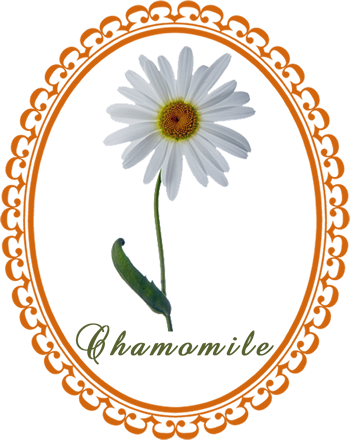
German Chamomile: this herb has plenty to offer - it helps regenerate liver cells, provides an antihistamine, and is unsurpassed for its stress-reducing effects ...
Common Names: Chamomile, Camomile
Botanical Names: Anthemis nobile (Roman or English Chamomile); Matricaria recutita (German Chamomile)
Family: Asteraceae
Plant Type: Hardy Annual
Parts Used: Flowers and leaves
Flowering: May to October
(Matricaria chamomilla) Wild Chamomile is an annual herb originally from Europe which has escaped to the wild and is now naturalized on almost every continent. It can now be found growing along fence rows, roadsides, and in sunny open fields from Southern Canada to Northern U.S. west to Minnesota.
Description: The branched stem is somewhat erect, round, hollow, and grows to about 20 inches tall. The leaves are bipinnate, finely divided, light green and feathery. The flowers are daisy-like about 1 inch across and bloom from May to October. The entire plant has a pineapple scent (apple to some) and planted in the garden is said to help sickly plants to grow. Gather the above ground parts as soon as flowers bloom, dry for later herb use.
Cultivation: Both chamomiles like sandy, well-drained soil, in full sun, with a pH of 6.7-7.0. Roman Chamomile is a perennial, low-growing, and semi-evergreen plant which makes a good groundcover; German Chamomile is taller and a reseeding annual.
Harvesting: Harvest flowers when open in summer, then dry.
Chamomile Magick
Love. Money. Purification.
Gender: Masculine
Planet: Sun
Element: Water
Chamomile attracts money.
Take a chamomile bath to attract love.
Use it in sleep and meditation incenses.
Sprinkle the herb around your property to remove curses and hexes.
Herbal Healing with Chamomile
Cosmetic Uses: Use an infusion of chamomile to add golden highlight to brown hair, or in a steam facial to help open pores.
Medicinal Actions: Analgesic, antianemic, antibacterial, anticonvulsive, antidepressant, antiemetic, antifungal, anti-inflammatory, antineuralgic, antipruritic, antirheumatic, antiseptic, antispasmodic, antistress, antitoxic, aperitive, calmative, carminative, cholagogue, cicatrizant, diaphoretic, digestive, diuretic, emmenagogue, emollient, febrifuge, hair/scalp tonic, healing, hepatic, hypotensor, laxative, nervine, regenerator (skin), sedative, stimulant (digestive system; spleen, uterine), stomachic, sudorific, tonic, vermifuge, vulnerary
Medicinal Uses: The volatile oils are an antispasmodic which can be used for treating indigestion and menstrual cramps. It is also an anti-inflammatory and anti-infective useful for treating skin disorders.
Body Care with German Chamomile
To soothe sunburn or wind-chapped skin, add 1 litre (4 cups) German chamomile flower infusion to your bath and soak in it for 20 minutes.
To soothe indigestion, gastritis and ulcers caused by nervous anxiety, take 1 teaspoon German chamomile tincture up to three times daily, as necessary.
Infusion: 1 teaspoon dried or 2 teaspoons fresh German chamomile flowers in 1 cup just-boiled water
Tincture: 200g (7 oz) dried or 400g (14 oz) fresh German chamomile flowers in 1 litre (4 cups) vodka-water mix.
Source: The Essential Herbs Handbook by Lesley Bremness
If you appreciate the information provided,
please help keep this website running. Blessings!
© 2008-2025 aromaworx.ca. All rights reserved.

